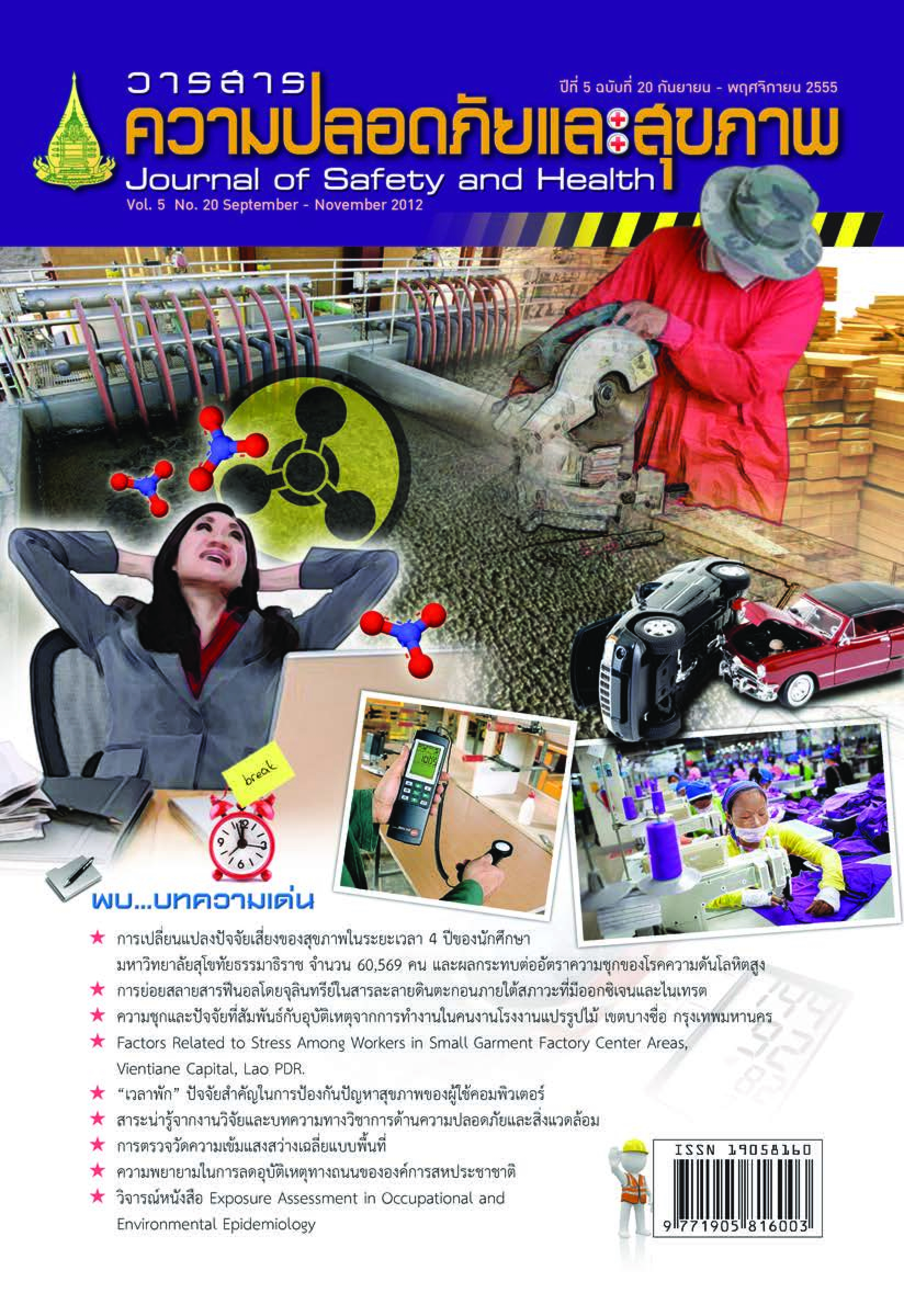การย่อยสลายสารฟีนอลโดยจุลินทรีย์ ในสารละลายดินตะกอนภายใต้สภาวะ ที่มีออกซิเจนและไนเทรต
Main Article Content
บทคัดย่อ
งานวิจัยนี้ศึกษาการย่อยสลายสารฟีนอลโดย จุลินทรีย์ในสารแขวนลอยดินตะกอนจากนาข้าวที่มี ไนเทรต (0.031 มิลลิโมลาร์) และไนไทรต์ (0.028 มิลลิโมลาร์) ภายใต้สภาวะที่มีออกซิเจนและไนเทรต เมื่อเติมสารฟีนอลลงไปในชุดทดลองที่ความเข้มข้น 0.1 มิลลิโมลาร์ ในครั้งที่ 1 และครั้งที่ 2 พบว่าจุลินทรีย์ ในสารแขวนลอยดินตะกอนสามารถย่อยสลายสาร ฟีนอลได้ภายในระยะเวลา 3 และ 2 วัน ตามลำดับ ต่อมาเติมสารฟีนอลความเข้มข้น 0.3 มิลลิโมลาร์ จาก การศึกษาครั้งนี้เป็นระยะเวลา 13 วัน พบว่าจุลินทรีย์ ในสารแขวนลอยดินตะกอนใช้เวลาการย่อยสลาย สารฟีนอลเป็นระยะเวลานานกว่า 5 วัน โดยพบว่ามี สารตัวกลางที่เกิดขึ้น คือ สารพาราไฮดรอกซีเบนโซเอท ซึ่งตรวจวัดได้ในวันที่ 3, 6 และ 9 ของการทดลอง โดย มีความเข้มข้นน้อยกว่า 0.01 มิลลิโมลาร์ และนอกจากนี้ ยังพบว่าจุลินทรีย์ในสารแขวนลอยดินตะกอนจากนาข้าวมี ความสามารถในการใช้ไนเทรตและเปลี่ยนเป็นไนไทรต์
Article Details

อนุญาตภายใต้เงื่อนไข Creative Commons Attribution-NonCommercial-NoDerivatives 4.0 International License.
Journal of Safety and Health is licensed under a Creative Commons Attribution-NonCommercial-NoDerivatives 4.0 International (CC BY-NC-ND 4.0) licence, unless otherwise stated.
เอกสารอ้างอิง
มนัส สุวรรณ (2532) นิเวศวิทยากับการพัฒนาเศรษฐกิจ. กรุงเทพฯ: โอเดียนสโตร์.
สุบัณฑิต นิ่มรัตน์ และสุกานดา เกื้อกิจกูล (2546) การ ย่อยสลาย p-Hydroxybenzoate โดยใช้ mixed cultureภายใต้สภาวะที่มีออกซิเจน.การประชุมวิชาการ ครั้งที่ 41 มหาวิทยาลัยเกษตรศาสตร์, กรุงเทพฯ, วันที่ 3 - 5 กุมภาพันธ์ 2546.
Association of Official American Chemists [AOAC]. (2002). Official methods of analysis. Association of Official American Chemists, MD.
Basha, K.M., Rajendran, A., & Thangavelu, V. (2010). Recent advances in the biodegradation of phenol: A review. Asian Journal of Experimental Biological Science, 1 (2), 219 - 234.
Bertani, I., Kojic, M., & Venturi, V. (2001). Regulation of the p-hydroxybenzoic acid hydroxylase gene (pobA) in plant-growth-promoting Pseudomonas putida WC358. Microbiology, 147, 1611 - 1620.
Caflan Karasu Benli, A., Sarikaya, R., Sepici Dincel, A., Selvi, M., Sahin, D., & Erkoc, F. (2007). Investigation of acute toxicity of (2,4- dichlorophenoxy) acetic acid (2,4-D) herbicide on crayWsh (Astacus leptodactylus Esch. 1823). Pesticide Biochemistry and Physiology, 88, 296 - 299.
Chakraborty, S., Bhattacharya, T., Pael, T.N., & Tiwari, K.K. (2010). Biodegradation of phenol by native microorganism isolated from coke processing wastewater. Journal of Environmental Biology, 31, 293 - 296.
Chen, Y.-X., Liu, H., & Chen, H.-L. (2003). Characterization of phenol biodegradation by Comamonas testosterone ZD4-1 and Pseudomonas aeruginisa ZD4-3. Biomedical and Environmental Science, 16, 163 - 172.
Dehkordi, F.N., Gharavi, S., & Soudi, M.R. (2012). Phenol Biodegradation by Two Bacterial Isolates from Agricultural Soil. Congress Portal for Ardabil University of Medical Sciences,The 13th Iranian & The Second International Congress of Microbiology.
Gayathri,K.V. & Vasudevan, N. (2010).Enrichment of phenol degrading moderately halophilic bacteria consortium from saline environment, Journal of Boiremediation & Biodegradation, 1 (1), 1 - 6.
Healy, J.B. & Young, L.Y. (1979). Anaerobic biodegradation of eleven aromatic compounds to methane. Applied and Environmental Microbiology, 38 (1), 84 - 89.
Latha, S. & Mahadevan, A. (1997). Review: Role of rhizobia in the degradation of aromatic substances. World Journal of Microbiology & Biotechnology, 13, 601 - 607.
Mutzel, A., Reinscheid, U.M., Antranikian, G., & Muller,R. (1996). Isolation and characterization of a thermophilic bacillus strain, that degrades phenol and cresol as sole carbon source at 700 C. Applied Microbiol Biotechnol, 46, 593 - 596.
Nair, C.I., Jayachadran,K., & Shashidhar,S. (2008). Biodegradation of phenol. African Journal of Biotechnilogy, 7 (25), 4951 - 4958.
Nakazawa, H., Takahashi, N., Inoue, K., Ito, Y., Goto, T., Kato, K., Yoshimura, Y., & Oka, H. (2004). Rapid and simultaneous analysis of dichlorvos, malathion, carbaryl, and 2,4-dichlorophenoxy acetic acid in citrus fruit by flow-injection ion spray ionization tandem mass spectrometry. Talanta, 64, 899 - 905.
Riazika, B., Abbes, B., Messaoud, C., & Soufi, K. (2010). Phenol and benzoic acid degradation by Pseudomonas aeruginosa. Journal of Water Resource and Protection, 2, 788 - 791.
Sarikaya, R. & Selvi, M. (2005). Investigation of acute toxicity of (2,4-dichlorophenoxy) acetic acid (2,4-D) herbicide on larvae and adult Nile tilapia (Oreochromis niloticus L.). Environmental Toxicology and Pharmacology, 20, 264 - 268.
Schwarzenbach,R.P., Gschwend,P.M., & Imboden, D.M. (1993). Environmental organic chemistry (1st ed). New York: John Wiley & Sons, Inc.
Shourian, M., Noghabi, K.A., Zahiri, H.S., Bagheri, T., Karballaei, G., Mollaei, M., Rad, I., Ahadi, S., Raheb, J., & Abbasi, H. (2009). Efficient phenol degradation by a newly characterized Pseudomonas sp. SA01 isolated from pharmaceutical wastewaters. Desalination, 246 (3), 577 - 594.
Stickland, J.D.H. & Parson, T.R. (1972). A practical handbook of seawater analysis (2nd ed.). Ottawa: Fisheries Research Board of Canada Bulletin.
Trabue, S.L., Ogram, A.V., & Ou, L.-T. (2001). Dynamics of carbofuran-degrading microbial communities in soil during three successive annual applications of carbofuran. Soil Biology & Biochemistry, 33, 75 - 81.
van Schie, P.M. & Young, L.Y. (1998). Isolation and characterization of phenol-degrading denitrifying bacteria. Applied and Environmental Microbiology, 64 (7), 2432 - 2438.
Varsha, Y.M., Deepthi CH, N., & Chenna, S. (2011). Anemphasis onxenobioticdegradation in environmental clean up. Journal of Boiremediation & Biodegradation, 11, 1 - 10.
Zhang, X. & Wiegel, J. (1994).Reversible conversion of 4 - hydroxybenzoate and phenol by Clostridium hydroxybenzoicum. Applied and Environmental Microbiology, 60 (11), 4128 - 4185.


